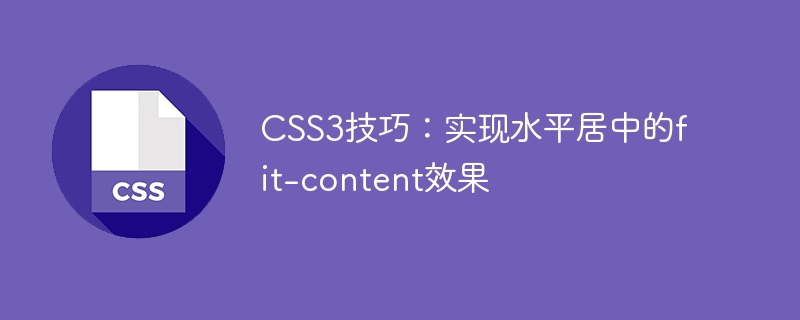

CSS3 Tips: Achieve horizontally centered fit-content effect
In web development, horizontal centering is a common layout requirement. Especially in responsive design, we often need to center elements horizontally to adapt to different screen sizes. This article will introduce a method to use CSS3 techniques to achieve a horizontally centered fit-content effect.
In the traditional horizontally centered layout, we often use the margin attribute to move the element to the left or right by half the width to achieve horizontal centering. However, in some special cases, we want an element to adapt to the width of its content, rather than having a fixed width centered. The fit-content attribute in CSS3 can meet such needs.
fit-content is a CSS3 size attribute that is used to specify that an element can automatically adjust to the size of the content without overflowing its containing block. Combined with the requirement of horizontal centering, we can achieve the horizontal centering effect of fit-content through the following steps:
Step 1: Create HTML structure
First, we need to create an HTML structure, which contains a horizontal centering Centered element. The following is an example HTML structure:
Hello World
In this example, we use a containing block (container) to wrap the element that needs to be centered (centered).
Step 2: Add CSS styles to elements
Next, we need to add CSS styles to these elements to achieve a horizontally centered fit-content effect. The following are the CSS styles that need to be added:
.container { display: flex; justify-content: center; align-items: center; height: 100vh; } .centered { width: fit-content; margin: 0 auto; }
In this example, we first set the display property of the containing block to flex, so that the element can be centered horizontally and vertically. We then set the width of the element that needs to be centered to fit-content so that it automatically adjusts to the width of its content. Finally, we use the margin attribute to center the element horizontally.
Step 3: Run and debug the code
After completing the above steps, we can run and debug the code. You can open the HTML file in a browser and adjust the width of the browser window to see whether the element can achieve the horizontally centered fit-content effect.
Code example:
Through the above code example, we can achieve a basic horizontally centered fit-content effect. You can try changing the content width and browser window size to see if the element adapts and remains horizontally centered.
Summary
This article introduces a method to use CSS3 techniques to achieve a horizontally centered fit-content effect. By setting the width of the element to fit-content, combined with the use of flex layout and margin attributes, we can easily achieve a horizontally centered adaptive effect. This method can make the web page present a good layout effect on different devices and improve the user experience. At the same time, we can also flexibly adjust and expand this method according to specific needs.
The above is the detailed content of CSS3 tips: achieve horizontally centered fit-content effect. For more information, please follow other related articles on the PHP Chinese website!